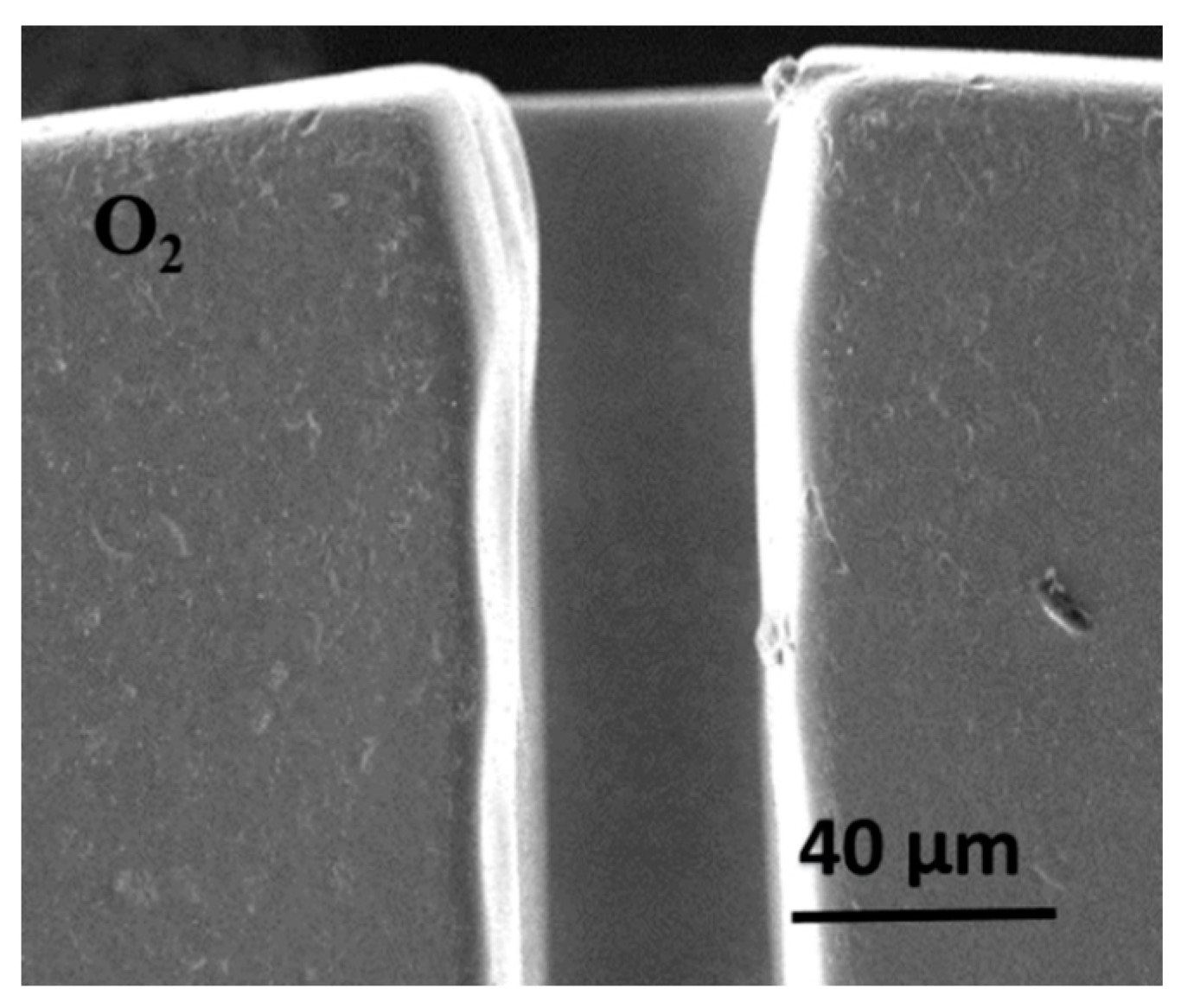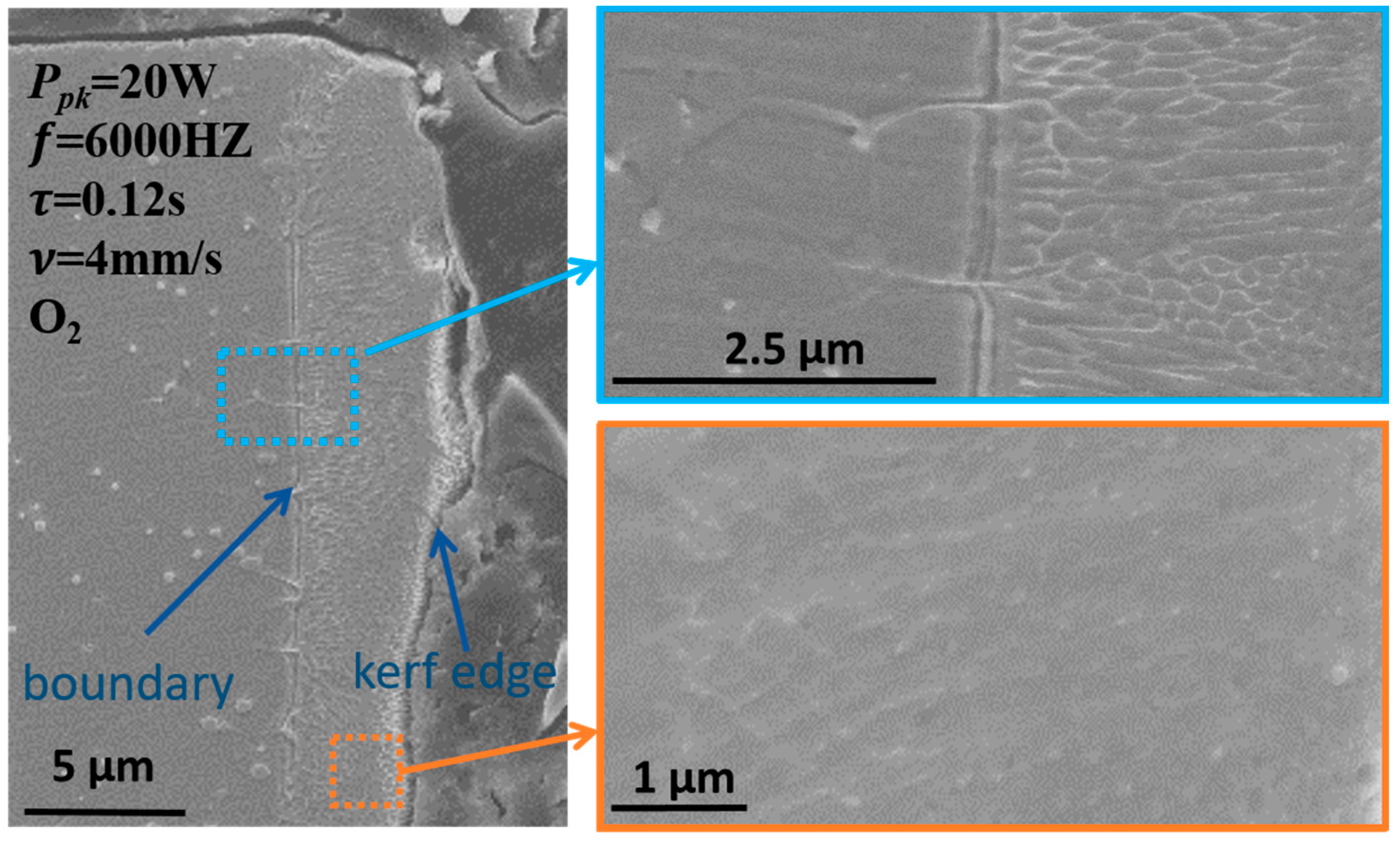The Influences of Assisting Gas Type and Process Parameters on the Fiber Laser Microprofiling of Thin CoCr Tubes for Vascular Stents
Abstract
:1. Introduction
2. Experimental Procedures
2.1. Materials
2.2. Laser Cutting
3. Results and Discussion
3.1. Influences of the Assisting Gas Type on Cutting Quality
3.1.1. Cutting Surface Topography
3.1.2. Element Compositions of the Cutting Surface
3.1.3. Kerf Geometry and Dross Formation
3.2. Influences of the Processing Parameters on Cutting Quality
3.2.1. Surface Topography
3.2.2. Kerf Width
3.2.3. Heat Affected Zone
4. Conclusions
Acknowledgments
Author Contributions
Conflicts of Interest
References
- Azaouzi, M.; Makradi, A.; Belouettar, S. Deployment of a self-expanding stent inside an artery: A finite element analysis. Mater. Des. 2012, 41, 410–420. [Google Scholar] [CrossRef]
- Weiss, S.; Mitevski, B. Microstructure and deformation of coronary stents from cocr-alloys with different designs. Materials 2015, 8, 2467–2479. [Google Scholar] [CrossRef]
- Hung, C.; Chang, F.; Chang, T.; Chang, Y.; Huang, K.; Liang, P. Micromachining NiTi tubes for use in medical devices by using a femtosecond laser. Opt. Laser Eng. 2015, 66, 34–40. [Google Scholar] [CrossRef]
- Yung, K.C.; Zhu, H.H.; Yue, T.M. Theoretical and experimental study on the kerf profile of the laser micro-cutting NiTi shape memory alloy using 355 nm Nd: YAG. Smart Mater. Struct. 2005, 14, 337. [Google Scholar] [CrossRef]
- Pfeifer, R.; Herzog, D.; Hustedt, M.; Barcikowski, S. PulsedNd: YAG laser cutting of NiTi shape memory alloys—Influence of process parameters. J. Mater. Process. Technol. 2010, 210, 1918–1925. [Google Scholar] [CrossRef]
- Meijer, J.; Du, K.; Gillner, A.; Hoffmann, D.; Kovalenko, V.S.; Masuzawa, T.; Ostendorf, A.; Poprawe, R.; Schulz, W. Laser machining by short and ultrashort pulses, state of the art and new opportunities in the age of the photons. CIRP Ann.-Manuf. Technol. 2002, 51, 531–550. [Google Scholar] [CrossRef]
- Sudheer, S.K.; Kothwala, D.; Prathibha, S.; Engineer, C.; Raval, A.; Kotadia, H. Laser microfabrication of L605 cobalt-chromium cardiovascular stent implants with modulated pulsed Nd: YAG laser. J. Microlithogr. Microfabr. Microsyst. 2008, 7, 1463. [Google Scholar] [CrossRef]
- Raval, A.; Choubey, A.; Engineer, C.; Kothwala, D. Development and assessment of 316LVM cardiovascular stents. Mater. Sci. Eng. A Struct. 2004, 386, 331–343. [Google Scholar] [CrossRef]
- Kleine, K.F.; Watkins, K.G. Fiber laser for micro cutting of metals. Proc. SPIE 2003, 4974, 185. [Google Scholar] [CrossRef]
- Meng, H.; Liao, J.; Zhou, Y.; Zhang, Q. Laser micro-processing of cardiovascular stent with fiber laser cutting system. Opt. Laser Technol. 2009, 41, 300–302. [Google Scholar] [CrossRef]
- Muhammad, N.; Whitehead, D.; Boor, A.; Li, L. Comparison of dry and wet fibre laser profile cutting of thin 316L stainless steel tubes for medical device applications. J. Mater. Process. Technol. 2010, 210, 2261–2267. [Google Scholar] [CrossRef]
- Demir, A.G.; Previtali, B.; Biffi, C.A. Fibre laser cutting and chemical etching of AZ31 for manufacturing biodegradable stents. Adv. Mater. Sci. Eng. 2013, 2013, 692635. [Google Scholar] [CrossRef]
- Demir, A.G.; Previtali, B.; Colombo, D.; Ge, Q.; Vedani, M.; Petrini, L.; Wu, W.; Biffi, C.A. Fiber Laser Micromachining of Magnesium Alloy Tubes for Biocompatible and Biodegradable Cardiovascular Stents. In Proceedings of the SPIE 8237, Fiber Lasers IX: Technology, Systems, and Applications, San Francisco, CA, USA, 21 January 2012; Volume 82373, pp. 1844–1864. [Google Scholar] [CrossRef]
- Fu, C.H.; Liu, J.F.; Guo, A. Statistical characteristics of surface integrity by fiber laser cutting of Nitinol vascular stents. Appl. Surf. Sci. 2015, 353, 291–299. [Google Scholar] [CrossRef]
- Sweeney, C.A.; Dunne, F.P.E.; McHugh, P.E.; Leen, S.B. Micro-scale testing and micromechanical modelling for high cycle fatigue of CoCr stent material. J. Mech. Behav. Biomed. Mater. 2015, 46, 244–260. [Google Scholar] [CrossRef] [PubMed]
- Muhammad, N.; Whitehead, D.; Boor, A.; Oppenlander, W.; Liu, Z.; Li, L. Picosecond laser micromachining of nitinol and platinum–iridium alloy for coronary stent applications. Appl. Phys. A 2012, 106, 607–617. [Google Scholar] [CrossRef]
- Muhammad, N.; Li, L. Underwater femtosecond laser micromachining of thin nitinol tubes for medical coronary stent manufacture. Appl. Surf. Sci. 2012, 107, 849–861. [Google Scholar] [CrossRef]
- Demir, A.G.; Previtali, B. Additive manufacturing of cardiovascular CoCr stents by selective laser melting. Mater. Des. 2017, 119, 338–350. [Google Scholar] [CrossRef]
- Liu, L.; Li, D.B.; Tong, Y.F.; Zhu, Y.F. Fiber laser micromachining of thin NiTi tubes for shape memory vascular stents. Appl. Phys. A 2016, 122, 1–9. [Google Scholar] [CrossRef]











| Element | Cr | Co | C | Si | P | S | Mn | Ni | Fe | W |
|---|---|---|---|---|---|---|---|---|---|---|
| Percentage | Balance |
| Cut # | Power () W | Repetition Rate () Hz | Pulse Width () ms | Speed () mm/s | Cut # | Power () | Repetition Rate () Hz | Pulse Width () ms | Speed () mm/s |
|---|---|---|---|---|---|---|---|---|---|
| 1 | 20 | 4500 | 0.12 | 4 | 13 | 17 | 6000 | 0.12 | 4 |
| 2 | 20 | 5000 | 0.12 | 4 | 14 | 18 | 6000 | 0.12 | 4 |
| 3 | 20 | 5500 | 0.12 | 4 | 15 | 19 | 6000 | 0.12 | 4 |
| 4 | 20 | 6000 | 0.12 | 4 | 16 | 20 | 6000 | 0.12 | 4 |
| 5 | 20 | 6500 | 0.12 | 4 | 17 | 21 | 6000 | 0.12 | 4 |
| 6 | 20 | 7500 | 0.12 | 4 | 18 | 22 | 6000 | 0.12 | 4 |
| 7 | 20 | 6000 | 0.09 | 4 | 19 | 20 | 6000 | 0.12 | 3 |
| 8 | 20 | 6000 | 0.10 | 4 | 20 | 20 | 6000 | 0.12 | 3.5 |
| 9 | 20 | 6000 | 0.11 | 4 | 21 | 20 | 6000 | 0.12 | 4 |
| 10 | 20 | 6000 | 0.12 | 4 | 22 | 20 | 6000 | 0.12 | 4.5 |
| 11 | 20 | 6000 | 0.13 | 4 | 23 | 20 | 6000 | 0.12 | 5 |
| 12 | 20 | 6000 | 0.14 | 4 | 24 | 20 | 6000 | 0.12 | 5.5 |
| Cut # | Power () W | Repetition Rate () Hz | Pulse Width () ms | Speed () mm/s | Cut # | Power () | Repetition Rate () Hz | Pulse Width () ms | Speed () mm/s |
|---|---|---|---|---|---|---|---|---|---|
| 1 | 30 | 4500 | 0.10 | 4 | 13 | 25 | 6000 | 0.10 | 4 |
| 2 | 30 | 5000 | 0.10 | 4 | 14 | 27.5 | 6000 | 0.10 | 4 |
| 3 | 30 | 5500 | 0.10 | 4 | 15 | 30 | 6000 | 0.10 | 4 |
| 4 | 30 | 6000 | 0.10 | 4 | 16 | 32.5 | 6000 | 0.10 | 4 |
| 5 | 30 | 6500 | 0.10 | 4 | 17 | 35 | 6000 | 0.10 | 4 |
| 6 | 30 | 7500 | 0.10 | 4 | 18 | 37.5 | 6000 | 0.10 | 4 |
| 7 | 30 | 6000 | 0.08 | 4 | 19 | 30 | 6000 | 0.10 | 3.3 |
| 8 | 30 | 6000 | 0.09 | 4 | 20 | 30 | 6000 | 0.10 | 3.65 |
| 9 | 30 | 6000 | 0.10 | 4 | 21 | 30 | 6000 | 0.10 | 4 |
| 10 | 30 | 6000 | 0.11 | 4 | 22 | 30 | 6000 | 0.10 | 4.35 |
| 11 | 30 | 6000 | 0.12 | 4 | 23 | 30 | 6000 | 0.10 | 4.7 |
| 12 | 30 | 6000 | 0.13 | 4 | 24 | 30 | 6000 | 0.10 | 5.0 |
| Original | Cr | Co | O | Mn | Ni | Fe | W |
| 1.09 % | |||||||
| Pickling | Cr | Co | O | Mn | Ni | Fe | W |
| 14.80% |
| Original | Cr | Co | O | C | S | Mn | Ni | Fe | W |
| 45.51% | 3.43% | 0.02% | 10.43% | ||||||
| Pickling | Cr | Co | O | C | S | Mn | Ni | Fe | W |
| 19.75 | 46.73 |
© 2017 by the authors. Licensee MDPI, Basel, Switzerland. This article is an open access article distributed under the terms and conditions of the Creative Commons Attribution (CC BY) license (http://creativecommons.org/licenses/by/4.0/).
Share and Cite
Liu, L.; Li, D.; Tong, Y.; Zhu, Y. The Influences of Assisting Gas Type and Process Parameters on the Fiber Laser Microprofiling of Thin CoCr Tubes for Vascular Stents. Appl. Sci. 2017, 7, 608. https://doi.org/10.3390/app7060608
Liu L, Li D, Tong Y, Zhu Y. The Influences of Assisting Gas Type and Process Parameters on the Fiber Laser Microprofiling of Thin CoCr Tubes for Vascular Stents. Applied Sciences. 2017; 7(6):608. https://doi.org/10.3390/app7060608
Chicago/Turabian StyleLiu, Lei, Dongbo Li, Yifei Tong, and Yufu Zhu. 2017. "The Influences of Assisting Gas Type and Process Parameters on the Fiber Laser Microprofiling of Thin CoCr Tubes for Vascular Stents" Applied Sciences 7, no. 6: 608. https://doi.org/10.3390/app7060608
APA StyleLiu, L., Li, D., Tong, Y., & Zhu, Y. (2017). The Influences of Assisting Gas Type and Process Parameters on the Fiber Laser Microprofiling of Thin CoCr Tubes for Vascular Stents. Applied Sciences, 7(6), 608. https://doi.org/10.3390/app7060608






